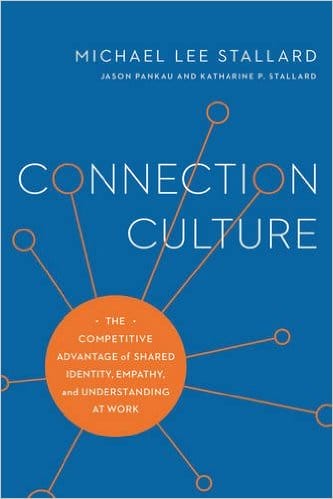There is a saying in American business circles that “Culture trumps strategy.” The basic idea is that the best strategy in the world is doomed if the culture of your organization does not support your vision. Mike Stallard, author of Connection Culture, takes this one step further and uses science and his unrelenting curiosity to dig deeper into what it means to have an effective culture that leads to better business results and healthier, more engaged, happier employees.
Stallard is not just another academic who takes a bird’s eye view of corporate America. He was the Chief Marketing Officer for the private wealth management businesses of both Morgan Stanley and Charles Schwab. He has lived in both effective and ineffective culture. Now, he is leading a cutting-edge consulting firm that is transforming businesses across the country.
Over the course of several years, Stallard combed the research on culture by reading books, sifting through hundreds of academic papers, interviewing experts and conducting original research to formulate his theories. At the highest level, his research points to the fact that there are basically three types of corporate cultures:
- Control – Organizations that fit this profile tend to have one person or a small group of people who have all the
 power. They dictate everything from strategy to tactics and how to execute. They tend to have very smart people at the top but they also like to micromanage to autonomy at lower levels is nonexistent. Most functions are centralized and people are simply expected to follow orders.
power. They dictate everything from strategy to tactics and how to execute. They tend to have very smart people at the top but they also like to micromanage to autonomy at lower levels is nonexistent. Most functions are centralized and people are simply expected to follow orders. - Indifference – These organizations seem to make up most of today’s organizations and they are our biggest threat to growth (both personally and economically). They are pervasive on Wall Street and even in Silicon Valley. They tend to be obsessively focused on tasks and results while neglecting the development of relationships. As a result, people feel as if they are on their own and isolated. And, more and more remote working opportunities are making the situation worse.
- Connection – These organizations are places where the culture supports close, intimate relationships where people actually care about each other. They value task excellence, results AND they invest time in building and maintaining relationships versus only being concerned with meeting goals. This type of culture leads to higher employee engagement, greater feelings of inclusivity, higher productivity and more innovation.
Based on those descriptions, it is fairly easy to see why a Connection Culture wins. But, why? This is one of the places where Stallards painstaking research and curiosity pay off big. Here are a couple of points he made to me in a recent conversation:
- Across the world, industrialized countries have boomed since World War II but have contributed to lower levels of connectedness.
- Loneliness is on the rise in our country and the antidote is connection. Stallard refers to connection as a “super power” in that true connection with other human beings leads to greater longevity, improved health, higher productivity and more happiness.
- Americans under the age of 50 have the lowest life expectancy in the industrialized world (See the Institute of Medicine report). We are near or at the bottom of about nine health outcomes including infant mortality and obesity. And, research shows that loneliness is only makes each of these worse…
One of my favorite stories from the book is when (unfortunately) Stallard’s wife Katie was diagnosed with ovarian cancer. One day, while Mike and Katie walked in the entrance of Memorial Sloan Kettering Cancer Center in New York City, a doorman named Nick gave them both a friendly greeting. Then, the woman at the reception desk greeted her (and everyone else) with “honey.” Their oncologist spent an entire hour with them discussing treatment options, educating them and answering their long list of questions.
It turns out that certain units of Sloan Kettering take employee connection and engagement very seriously. Mike and Katie felt cared for and that even the doorman was invested in Katie’s care. They do not hesitate to recommend the hospital to anyone and everyone.
So, what can you do to create a Connection Culture at your organization? Here are a couple of tips from Stallard:
- Recognize that connection is a super power and invest the time and energy to create supportive, intimate relationships with your colleagues, customers and partners.
- Be curious with other people. Do your best to withhold judgment and just listen. Others will feel that they have a voice and be more likely to speak up when it really counts.
- Think about connection when recruiting new employees. Hire people who have demonstrated that they value connection.
- Download Stallard’s 28-page ebook entitled “100 Ways to Connect.”
- Whether you are a manager or a C-Level executive, develop an inspiring vision for your organization that helps move people from “me” to “we.”
There are still some lonely people out there who think the sole purpose of a business to produce a profit. Unfortunately, profits are just like oxygen. Oxygen makes life possible but not necessarily worth living. And, Stallard writes, “Connection is what transforms a dog-eat-dog environment into a sled dog team that pulls together.”




